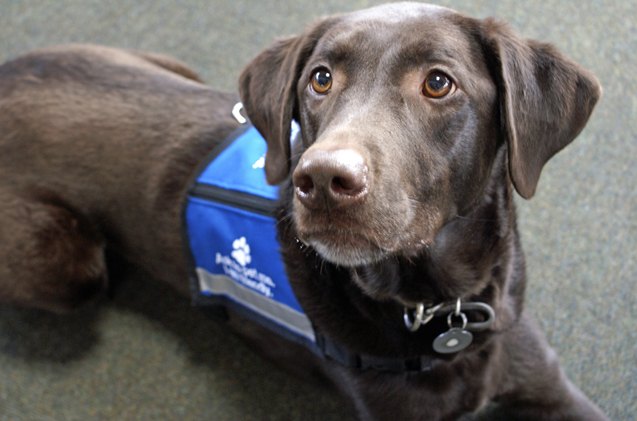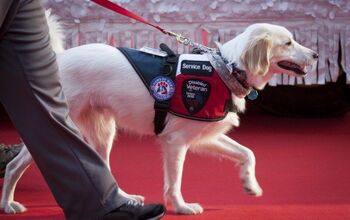Why Can’t I Pet Service Dogs?

When you see a dog while you are out and about in your daily life, your first instinct is probably to go over and make friends. While there is certainly no harm in wanting to make friends with every dog you meet, you need to be careful about overstepping your bounds.
Not every dog is going to respond well to being approached by strangers and there are situations where approaching an unfamiliar dog is actually taboo – this is the case for service dogs.
Related: Top 10 Therapy Dog Breeds
More Than Petting – Things to Avoid
The number-one rule for service dogs is that you should never pet them. This isn’t because service dogs aren’t friendly or because they won’t respond well – it is because a service dog is trained to do his job and you trying to pet him could interfere with that.
Related: National Service Dogs
Even if it looks like the dog is just lying around, he is always on duty. Not only is it taboo to pet a service dog without permission, but you should also avoid distracting the dog by talking to it, moving too close, touching the dog’s equipment, or attempting to come between the dog and his person.
Other Things You Should Know About Service Dogs
Not petting the dog is the most important rule for service dogs, but there are some other things the people who use service dogs want you to know:
- A service dog is more than just a pet – it is a lifeline. While some people use service dogs for mental health issues and minor disabilities, there are people whose service dogs are a literal lifeline – the dog being able to properly perform its job could be the difference between life and death for that person.
- Having a service dog doesn’t mean you can ask the person about the condition that necessitates the dog – their medical history is just as private as yours, so don’t ask questions, even if you don’t see any physical evidence of handicap or disability.
- Not all service dogs look alike. You may think you know what a service dog looks like but, in reality, they come in all breeds, shapes, sizes, colors, and ages. Some dogs have a greater aptitude for certain types of service, so it really depends on the situation.
- Just because a service dog is technically always on the job doesn’t mean he isn’t loved. A person’s service dog is just as much their friend and companion as any dog would be – you have no reason to feel sorry for a service dog because he spends so much time working.
- People with service dogs are protected by federal law – they are legally allowed to go anywhere the public is allowed to go. It is illegal to deny service or entry to someone because they have a service dog. Service dogs are trained to behave properly in public.
Service dogs are trained to fulfill a wide variety of roles. There are service dogs who offer mobility assistance, those who act as medical alert dogs, and dogs who support individuals with psychiatric disorders. As much as you might like to pet a service dog or talk to his handler, the best rule to follow is polite ignorance.

Kate Barrington is the loving owner of two cats (Bagel and Munchkin) and a noisy herd of guinea pigs. Having grown up with golden retrievers, Kate has a great deal of experience with dogs but labels herself a lover of all pets. Having received a Bachelor's degree in English, Kate has combined her love for pets and her passion for writing to create her own freelance writing business, specializing in the pet niche.
More by Kate Barrington























